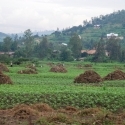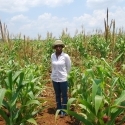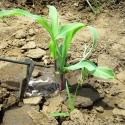17 Feb 2011
Does Pattern Matter?
Exploring impact of soil type and resource management on village-scale soil organic matter gradients
Introduction
A collaborative project with Wageningen University is exploring the impact of land-use, farmer management practices and soil type on village-scale variability in soil fertility. Many studies recognize nutrient and management gradients in smallholder farms in sub-Saharan Africa (Giller et al. 2006; Tittonell et al. 2007a; Tittonell et al. 2007b; Zingore et al. 2007; Masvaya et al. 2009). Small-holders typically have limited amounts of resources that are preferentially used on fields near the homesteads. This, combined with natural variability of soils results in a complex pattern of soil fertility gradients.
In Zimbabwe remarkable gradients of soil fertility between smallholder farms have been recorded (Zingore et al. 2010). These differences in soil fertility can be linked to opportunities of improving nutrient use efficiency and crop production (Tittonell et al. 2007b). There has been recent attempts to explicitly explore soil fertility variability at the village level (Zingore et al. 2010; Rufino et al. 2011). Village level assessment of soil fertility gradients allow to study a range of spatial relations such as distance to the farm, history of ownership, soil type, soil texture and compare these between fields. Moreover a village level assessment include the grazing areas, which play a crucial role in recycling of carbon and nutrients (Rufino et al. 2011).
The fertility gradients are expressed among other things as differences in soil organic carbon (SOC) content of the fields. SOC has been identified as an essential natural resource in many agro-ecosystems. It is considered to be the most important indicator of soil quality and agronomic sustainability, because of its impact on the physical, chemical and biological soil properties (Reeves, 1997). The accumulation of SOC is determined by the amount of carbon added as well as the soil particle size distribution.
Objectives
The main objective of the project is to identify the landscape management interactions that determine spatial variability in SOC in smallholder farming systems in NE Zimbabwe. The pattern of SOC distribution across different fields will be used to develop spatially exploits nutrient management recommendation that improve nutrient use efficiencies.
Study approach
The study is being conducted in the Murewa smallholder farming area (population density 104 people km-2) which is located about 80 km east of Harare (17˚49’S, 31˚34’E). The area has a sub-tropical climate and is characterized in Zimbabwe as having a high potential for crop production receiving 750–1000 mm rainfall annually, distributed in a unimodal pattern (December–April). The soils in the area are predominantly granitic sandy soils (Lixisols) with low inherent fertility. A smaller proportion of the area has more fertile dolerite-derived clay soils (Luvisols) that are considered the best agricultural soils in Zimbabwe (Nyamapfene 1991). Farmers practice a mixed crop-livestock system with maize (Zea mays L.) as the dominant staple crop. Cattle are the main livestock and freely graze in a communal rangelands during the day and are tethered in kraals close to homesteads at night. Close interaction between crop and cattle production occurs through crop residues that are used to feed cattle and the reciprocal use of manure to fertilize crops.
Soil sampling and analysis
A stratified random sampling method (de Gruijter et al. 2006) is applied. Beforehand three strata were defined on the basis of LandSat TM satellite data taken in September 2008. In Murewa, September is at the end of the dry season so all biomass from the fields is removed and bare soil is visible. The three strata roughly coincide with the cropping area in the sandy soils (210 ha), the red clay and valleys (235 ha) and a granite, stoney area (140 ha). Subsequently a clustering method and a maximum likelihood classification in arcGIS were applied to define the strata. A minimum region area of one hectare was used. Within the strata a simple random sampling scheme was used. To assess the carbon stock, volumetric samples are taken from the 0-20 cm depth. We sampled 72 points in the area covered by sandy soil, 21 points under red. Additionally 12 duplicates were taken to assess the analysis error. The volumetric samples were air dried and weighted to derive the bulk density. Carbon and nitrogen were measured via CN-Autoanalyser. At every sample location the current land use, its history and ownership was recorded.
Modeling
A simple dynamic model will be used to explore interactions between management and SOC dynamics. A sub-model of the FIELD model previously calibrated for the study site will be used (Tittonell et al. 2007b). To investigate the relation between SOC and model parameters a Monte Carlo simulation will be applied. Latin-hypercubes will be generated to obtain the distribution of plausible parameter values from a multidimensional distribution. A village level map of carbon gradients will be generated using geo-statistical techniques and satellite images. This map combined with the output of the Monte Carlo simulation will allow the simulation of soil and management factors affecting SOC variability at the village level. This gradients form a pattern which can be related field-specific nutrient management practices and the resilience of the system (Dakos et al. 2010).
Expected outputs
This research will generate an approach for village-scale analysis of spatial distribution of SOC in smallholder farming systems. The inverse modelling exercise will also provide an increased understanding of the key drivers of SOC gradients at the village level. These outputs will yield a baseline for future projects aiming to provide farm-specific nutrient management recommendations.
References
Dakos, V., van Nes, E.H., Donangelo, R., Fort, H., Scheffer, M. 2010. Spatial correlation as leading indicator of catastrophic shifts. Theoretical Ecology 3(3):163-174.
de Gruijter, J.J., Brus, D.J., Bierkens, M.F.P., Knotters, M. 2006. Sampling for natural resource monitoring. Springer, Berlin [etc.].
Giller, K.E., Rowe, E.C., Ridder, N.d., Keulen, H.v. 2006. Resource use dynamics and interactions in the tropics: Scaling up in space and time. Agricultural Systems 88(1):8-27.
Masvaya, E.N., Nyamangara, J., Nyawasha, R.W., Zingore, S., Delve, R.J., Giller, K.E. 2009. Effect of farmer management strategies on spatial variability of soil fertility and crop nutrient uptake in contrasting agro-ecological zones in Zimbabwe. Nutrient Cycling in Agroecosystems:1-10.
Nyamapfene, K.W. 1991. Soils of Zimbabwe. Nehanda Publishers (Pvt) Ltd, Harare.
Rufino, M.C., Dury, J., Tittonell, P., van Wijk, M.T., Herrero, M., Zingore, S., Mapfumo, P., Giller, K.E. 2011. Competing use of organic resources, village-level interactions between farm types and climate variability in a communal area of NE Zimbabwe. Agricultural Systems 104(2):175-190.
Tittonell, P., Vanlauwe, B., de Ridder, N., Giller, K.E. 2007a. Heterogeneity of crop productivity and resource use efficiency within smallholder Kenyan farms: Soil fertility gradients or management intensity gradients? Agricultural Systems 94(2):376-390.
Tittonell, P., Zingore, S., van Wijk, M.T., Corbeels, M., Giller, K.E. 2007b. Nutrient use efficiencies and crop responses to N, P and manure applications in Zimbabwean soils: Exploring management strategies across soil fertility gradients. Field Crops Research 100(2-3):348-368.
van Apeldoorn, D.F., Sonneveld, M.P.W., Kok, K. Landscape asymmetry of soil organic matter as a source of agro-ecosystem resilience. Agriculture, Ecosystems & Environment In Press, Corrected Proof.
Zingore, S., Murwira, H.K., Delve, R.J., Giller, K.E. 2007. Influence of nutrient management strategies on variability of soil fertility, crop yields and nutrient balances on smallholder farms in Zimbabwe. Agriculture, Ecosystems & Environment 119(1-2):112-126.
Zingore, S., Tittonell, P., Corbeels, M., van Wijk, M.T., Giller, K.E. 2010. Managing soil fertility diversity to enhance resource use efficiencies in smallholder farming systems: a case from Murewa District, Zimbabwe. Nutrient Cycling in Agroecosystems:1-17..




